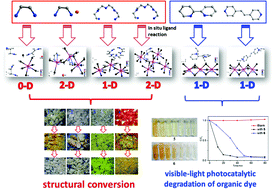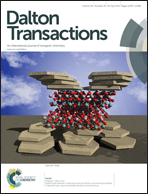A comparison study of aliphatic and aromatic structure directing agents influencing the crystal and electronic structures, and properties of iodoplumbate hybrids: water induced structure conversion and visible light photocatalytic properties†
Abstract
The introduction of the aliphatic amines en (ethylenediamine), aep (N-(2-aminoethyl)piperazine) and tepa (tetraethylenepentamine), and the aromatic species 2,2′-bipy (2,2′-bipyridine) and dpe (1,2-di(4-pyridyl)ethylene) as structure directing agents (SDAs) into inorganic iodoplumbates affords six hybrids, namely [(Hen)4(H2.5O)2I](PbI6) (1), Cs2n[Pb3I8(en)2]n (2), (H3tepa)n(PbI5)n (3), (H2aep)n(PbI4)n (4), (Et22,2′-bipy)n(Pb2I6)n (5) and (Et2dpe)n(Pb2I6)n (6). 1 contains a discrete octahedral (PbI6)4− anion generated under the direction of a novel co-template, [(Hen)4(H2.5O)2I]4+. 2 contains inorganic Cs+ ions and a novel hybrid anionic layer [Pb3I8(en)2]n2n− that has never been encountered in iodoplumbate hybrids. 3 features a zigzag (PbI5)3− chain with the charge being compensated by a triprotonated tepa cation. 4 is composed of perovskite sheets of lead(II) octahedra and aep cations that are generated from tepa via an unprecedented in situ ligand reaction. Both 5 and 6 have (Pb2I6)n2n− chains and represent the first example of introducing a 2,2′-bipy or dpe derivative cation in iodoplumbate hybrids, respectively. The comparative study reveals that aliphatic amines and aromatic species contribute differently to the crystal and electronic structures, and the properties of the hybrids. Importantly, 1–4 exhibit interesting water induced structure conversions, while 5 and 6 can be used as heterogeneous photocatalysts for dye wastewater treatment under visible light irradiation.



 Please wait while we load your content...
Please wait while we load your content...